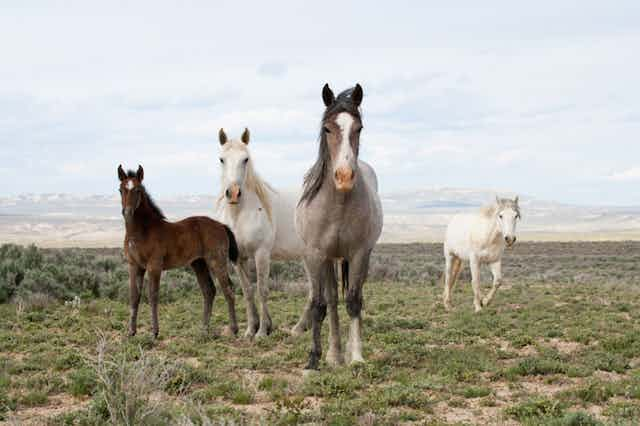We had driven the land cruiser for half a day across the seemingly endless reaches of the Great Basin, the vast, near-waterless region of valleys and plains that stretches out from Nevada in the western US and into neighbouring states. A mile away on the side of a mountain I spotted through binoculars the object of my quest: a small band of wild horses ambling slowly downhill, the alpha mare in the lead with her brood stallion bringing up the rear.
Locating wild horses in the Great Basin has occupied me for years. For all the time and effort, success still relies more on luck and persistence than skill. Yet as often as I’ve seen them, they never fail to inspire. Human fascination with wild horses, known as mustangs in the US, is as undeniable as it is inexplicable. Perhaps anthropologist Elizabeth Atwood Lawrence had it right when she said: “Of all animals perhaps the horse is uniquely suited to represent the conquest of the wild – the extension of culture into nature.”
With only two humans per square mile it is by far the least densely populated part of America, but it is currently home to some 50,000 free-roaming wild horses and burros under the care and protection of the Bureau of Land Management (BLM), a US government agency.
The animals are scattered throughout the desert typically surviving in small family bands. They have no single coat color, and can appear as bay, brown, black, sorrel, chestnut, white, buckskin, gray, palomino, pinto, and blue, red and strawberry roans. The breeds are mixtures of everything from draft horses and thoroughbreds to everyday grade horses. They are largely the descendants of strays from western cattle ranching, mining and the military. Only a small number are direct descendants of the horses introduced by the Spanish conquistadors and passed through Native American hands – true living history.
Wild horses may provide inspiration to some – see the sports car and fighter plane that bear their name. But to others such as the ranchers who rely upon the federal lands for their livelihood and for whose cattle the horses compete for scarce feed and water, they are a curse on the land. With such divergence between wild horse admirers and their haters, it is small wonder wild horses rank among the most challenging of public land issues.
Cattlemen just prior to and after World War II, in an attempt to clear their grazing allotments of these unwanted animals, hired agents known as “mustangers”, whose job was to remove the wild horses by any means possible. Frightened horses were pursued with motorised vehicles until exhausted, lassoed, tied down, and hauled to slaughter houses. Western ranchers removed these animals from their federal grazing allotments at such an alarming rate that by the late 1960s they numbered fewer than 18,000.

The struggle to save what remained of the West’s wild horses began with a secretary named Velma Bronn Johnston. The particular event that brought this woman into the fray occurred not on the open range, but rather on the streets of downtown Reno, Nevada. One day in 1950, while driving to work, she happened alongside a cattle truck filled with wild horses headed for slaughter and saw blood dripping from underneath it onto the city street.
The incident so disturbed Johnson that she soon dedicated her life to seeking protection for her “wild ones” as she called them. Along the way, she even acquired the nickname “Wild Horse Annie”, first given by her enemies as a sign of contempt, but then worn as a badge of honour. Johnson’s journey would eventually carry her far beyond her enemies, from Reno to Washington, DC and the Halls of Congress.
In 1971 Congress passed, and President Richard Nixon signed into law, the Wild Free-Roaming Horses and Burros Act. The product of more than a decade of tireless effort on the part of Johnson and her colleague, Congressman Walter Baring of Nevada, the law was intended to protect the few remaining mustangs and burros on public lands as “living symbols of the pioneer spirit of the West”.
The rangeland these animals now occupy, alongside cattle, wildlife and human hikers, is owned and managed by the federal government. And it is the fierce human competition over these “multiple-use lands” that rests at the heart of the wild horse controversy. Extreme positions have all but ruled-out compromise thus contributing to a serious state of policy gridlock.
The single greatest problem facing the BLM is the excessive reproduction of wild horses. Each year their numbers increase by about 20%, doubling their population every five years. Round-ups and public adoptions are held, but these are not sufficient to offset the natural increase. As a result, some 47,000 animals are currently in long-term holding facilities waiting out their lives far from the free roaming life originally envisioned by Wild Horse Annie. The BLM has set a target population of about 27,000 for the free roaming animals. As previously noted, the current population is nearly double that.
While it’s possible, extinction seems an unlikely fate for the wild horses. The challenge is more one of proper management, especially with respect to controlling overpopulation. In this regard, the BLM is experimenting with fertility control. One can only hope that the disputing factions can come together with BLM and workout an amicable solution.

